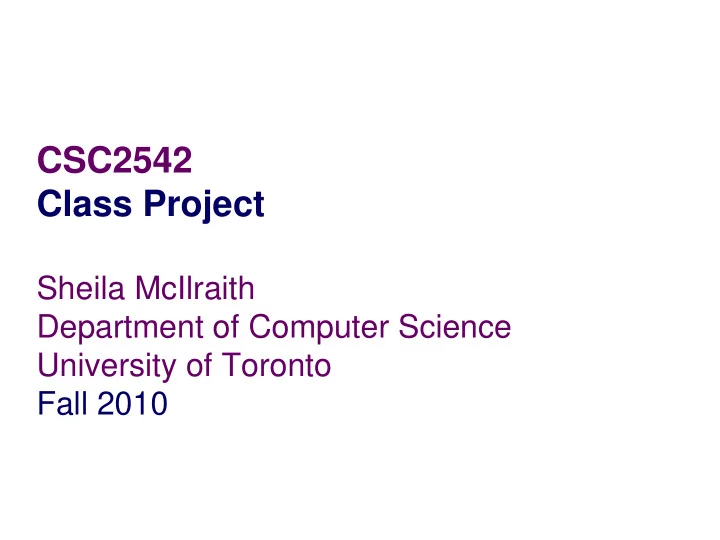

CSC2542 Class Project Sheila McIlraith Department of Computer Science University of Toronto Fall 2010
Examples The next few pages contain examples of what you might need to do � for various kinds of projects. These are just samples to get you started thinking …
Example 1 Suppose you want to compare algorithm X with algorithm Y � � E.g., compare Satplan with HPLAN-P Has someone already done it? (check the literature) � Theoretical comparison? � � Expressivity: are there domains that one algorithm can represent/solve but the other can’t (or can’t represent as well)? � Worst-case complexity: does it mean much in practice? � Average-case analysis: probably pretty difficult Experimental study? � � How can you be sure the experiments mean anything? � Randomly generated problems? What about built-in bias? � Problems from the planning competition? � Statistical significance? Confounding factors? Overall significance of the results? � � Does it say something general, or just about one kind of problem?
Example 2 Suppose you want to apply AI planning to some application X � � Do you know enough about X to do a credible job? � Has someone already done it? (check the literature) � Analyze real-world requirements � Formalize the problem � Which algorithm? What kind of algorithm? � Domain-independent, domain- customized, domain-specific? � What makes your algorithm better than others for this problem? � Maybe compare two algorithms? (see example 1) � What will you do if the algorithm doesn’t work well?
Example 3 Suppose you want to extend algorithm X to include feature Y � E.g., modify Satplan, FastForward or some other planner � � To include preferences, state variables, temporal reasoning, resource management, control rules, or dependency-directed backtracking � To produce conditional or conformant plans � To work in multi-agent environments (cooperative? adversarial?) Has someone already done it? (check the literature) � What is the motivation for the feature? (sometimes trivial to address) � What characteristics does your algorithm have? � � Soundness, completeness, efficiency? � General idea or just a hack? Experimental evaluation (see example 2) � Overall significance? � � How general is your approach? Could it be made to work for other algorithms as well? � Does your approach extend to other algorithms? � Good for just one kind of problem, or for many? Which ones?
Some things to think about… If you succeed in carrying out your idea, will the result be interesting? � � Interesting to you? Interesting to others? What is needed to carry out your idea � � Is it too hard to accomplish in the amount of time that you have? Is it too easy to count as a “real” project? How do you ensure success regardless of how the result turns out? � � If the only interesting/significant result is “yes it works,” then you’ll be in trouble if you can’t actually get it to work. You should either � (1) think enough about it to be pretty sure you can get it to work, or � (2) reformulate it in such that any of the likely outcomes will be interesting as the main result of your project
Assessment Criteria Your project doesn’t have to necessarily make a new research contribution, though this would be nice! The primary objective is pedagogical. Nevertheless, as you train to be good researchers, it is good to evaluate whether your work is a research contribution. To that end, here are some of the questions that are often asked of reviewers assessing your work for publication (ICAPS-07 review form): Rank (1=bad, 5=middle, 10=good) � Reviewer familiarity * � Relevance to the call of papers * � Technical quality and soundness * � Originality and novelty * � Significance to theory and practice * � Readability and organization * � Overall recommendation *
Assessment Criteria (cont.) ORIGINALITY � Is the work described in the paper novel? - SIGNIFICANCE � - Is the work important? - [Research Track] Does the work present theoretical or experimental results that advance the current state of the art in planning and scheduling? - [Application Track] Does the work describe a high-impact application or use of planning and scheduling technologies in anoperational setting? - [System Track] Does the paper describe a significant integration of diverse component technologies into complex planning, scheduling and execution systems?
Assessment Criteria (cont. 2) TECHNICAL QUALITY � - Is the work technically sound? - Are the paper's arguments compelling? - Is there a compelling empirical evaluation? - [Application Track] Does the work clearly rationalize the use of planning/scheduling technologies in the target application and quantify the benefit over current practice? - [System Track] Does the work present a successful integration of planning, scheduling, learning, constraint satisfaction or other technologies into a system that solves a well-defined problem? Does the system represent a well-engineered solution to the problem? QUALITY OF PRESENTATION � - Is the paper clearly written? - Does the paper motivate the research or application? - Is the paper well organized?
Specific Project Ideas <we can discuss one on one>
Recommend
More recommend